Podcast
Questions and Answers
What is the Central Dogma of Molecular Biology?
What is the Central Dogma of Molecular Biology?
The Central Dogma of Molecular Biology is the fundamental direction of genetic information flow during gene expression, which states that "DNA makes RNA makes Proteins".
What is the Central Dogma of Molecular Biology and who proposed it?
What is the Central Dogma of Molecular Biology and who proposed it?
The Central Dogma of Molecular Biology is the fundamental direction of genetic information flow during gene expression, which is "DNA makes RNA makes Proteins". It was proposed by Francis Crick.
What is the Central Dogma of Molecular Biology?
What is the Central Dogma of Molecular Biology?
The Central Dogma of Molecular Biology is the fundamental direction of genetic information flow during gene expression, which is “DNA makes RNA makes Proteins”.
What are the four letters that make up DNA's alphabet?
What are the four letters that make up DNA's alphabet?
What are the four letters that make up DNA's alphabet?
What are the four letters that make up DNA's alphabet?
What is the alphabet of DNA, and how does it define a molecule's partners?
What is the alphabet of DNA, and how does it define a molecule's partners?
What is transcription?
What is transcription?
What is transcription?
What is transcription?
What is the difference between RNA and DNA in terms of their structures?
What is the difference between RNA and DNA in terms of their structures?
What is a gene?
What is a gene?
What is transcription, and what is the name of the protein complex that carries it out?
What is transcription, and what is the name of the protein complex that carries it out?
What is a codon?
What is a codon?
What are promoters, and how do they define where a gene is expressed?
What are promoters, and how do they define where a gene is expressed?
What is translation?
What is translation?
What is the role of RNA polymerase in transcription?
What is the role of RNA polymerase in transcription?
What is the genetic code?
What is the genetic code?
What is a gene, and what is another name for it?
What is a gene, and what is another name for it?
What is RNA polymerase?
What is RNA polymerase?
What is the difference between DNA and RNA?
What is the difference between DNA and RNA?
What is the genetic code, and what is each group of three bases coding for an amino acid called?
What is the genetic code, and what is each group of three bases coding for an amino acid called?
What is translation?
What is translation?
What is the purpose of promoters?
What is the purpose of promoters?
What is the difference between DNA and RNA?
What is the difference between DNA and RNA?
What is translation, and what is the name of the molecule that leaves the nucleus during it?
What is translation, and what is the name of the molecule that leaves the nucleus during it?
What is the difference between prokaryotic and eukaryotic translation?
What is the difference between prokaryotic and eukaryotic translation?
How many nucleotides are used to code for one amino acid, and how many combinations would two nucleotides produce?
How many nucleotides are used to code for one amino acid, and how many combinations would two nucleotides produce?
What is the role of promoters in gene expression?
What is the role of promoters in gene expression?
What is the significance of complementary base pairing in genetic material?
What is the significance of complementary base pairing in genetic material?
What is the name of the virus discussed in the article, and what type of RNA does it have?
What is the name of the virus discussed in the article, and what type of RNA does it have?
What is the genetic code?
What is the genetic code?
What is Prion-like propagation, and in what disease is it discussed in the article?
What is Prion-like propagation, and in what disease is it discussed in the article?
What is the purpose of the codons in the genetic code?
What is the purpose of the codons in the genetic code?
What are the three stages of transcription?
What are the three stages of transcription?
What is the common feature of life discussed in the article?
What is the common feature of life discussed in the article?
What is the common feature of life discussed in the article, and what is the evolved feature of life on this planet?
What is the common feature of life discussed in the article, and what is the evolved feature of life on this planet?
What is the Central Dogma's view on information flow?
What is the Central Dogma's view on information flow?
Flashcards are hidden until you start studying
Study Notes
Studying That Suits You
Use AI to generate personalized quizzes and flashcards to suit your learning preferences.



